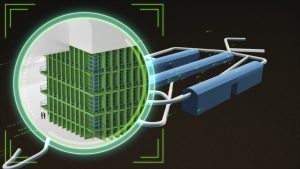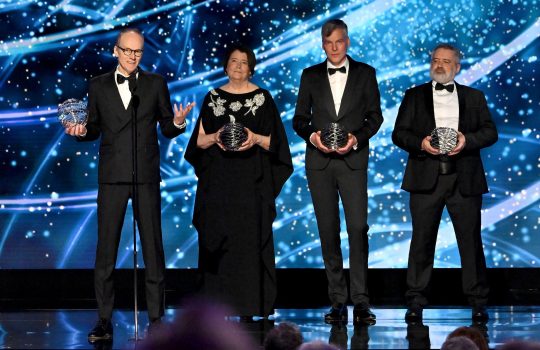The neutrino, it would seem, has global appeal.
The mysteries surrounding the renegade particle are attracting a worldwide science community to the future DUNE experiment. DUNE — the Deep Underground Neutrino Experiment — is a multinational effort to address the biggest questions in neutrino physics. More than 950 researchers from 30 countries have joined the DUNE collaboration, and both numbers are trending upward: Back in 2015, the collaboration comprised about 560 scientists and engineers from 23 countries.
It’s currently the largest particle physics project being undertaken anywhere in the world since the Large Hadron Collider at the European laboratory CERN. Modeled after CERN’s ATLAS and CMS experiments, the DUNE collaboration is an international organization. The experiment will be hosted in the United States by Fermi National Accelerator Laboratory.
The latest countries to join DUNE include Chile and Peru. The most recent new institutes to join DUNE come from Colombia, the UK and the US.
“It’s the excitement that’s being generated by the science,” said DUNE spokesperson Mark Thomson, a professor of physics at the University of Cambridge in the UK. “Everybody recognizes the DUNE program as strong, and the technology is interesting as well.”
It’s a tall order that will take a global village to fill, and researchers worldwide are currently building or signing up to build the experiment, taking advantage of DUNE’s broad scientific and geographic scope.
“We’re a country that does a lot of theoretical physics but not a lot of experimental physics, because it’s not so cheap to have a particle physics experiment here,” said Brazilian DUNE collaborator Ana Amelia Machado, a collaborating scientist at the University of Campinas and a professor at the Federal University of ABC in the ABC region of Brazil. “So we participate in big collaborations like DUNE, which is attractive because it brings together theorists and experimentalists.”
Machado is currently working on a device named Arapuca, which she describes as a photon catcher that could detect particle phenomena that DUNE is interested in, such as supernova neutrino interactions. She’s also working to connect more Latin American universities with DUNE, such as the University Antonio Nariño.
On the opposite side of the world, scientists and engineers from India are working on upgrading the high-intensity proton accelerator at Fermilab, which will provide the world’s most intense neutrino beam to the DUNE experiment. Building on the past collaborations with other Fermilab experiments, the Indian scientists are also proposing to build the near detector for the DUNE experiment. Not only are India’s contributions important for DUNE’s success, they’re also potential seeds for India’s own future particle physics programs.

More than 950 researchers from 30 countries have joined DUNE. Collaborators are developing new technologies for DUNE’s particle detectors, giant instruments that will help capture the notoriously elusive neutrino.
“It’s exciting because it’s something that India’s doing for the first time. India has never built a full detector for any particle physics experiment in the world,” said Bipul Bhuyan, a DUNE collaborator at the Indian Institution of Technology Guwahati. “Building a particle detector for an international science experiment like DUNE will bring considerable visibility to Indian institutions and better industry-academia partnership in developing advanced detector technology. It will help us to build our own future experimental facility in India as well.”
DUNE’s two particle detectors will be separated by 800 miles: a two-story detector on the Fermilab site in northern Illinois and a far larger detector to be situated nearly a mile underground in South Dakota at the Sanford Underground Research Facility. Fermilab particle accelerators, part of the Long-Baseline Neutrino Facility for DUNE, will create an intense beam of neutrinos that will pass first through the near detector and then continue straight through Earth to the far detector.
Scientists will compare measurements from the two detectors to examine how the neutrinos morphed from one of three types into another over their interstate journey. The far detector will contain 70,000 tons of cryogenic liquid argon to capture a tiny fraction of the neutrinos that pass through it. DUNE scientists are currently working on ways to improve liquid-argon detection techniques.
The near detector, which is close to the neutrino beam source and so sees the beam where it is most intense, will be packed with all kinds of components so that scientists can get as many readings as they can on the tricky particles: their energy, their momentum, the likelihood that they’ll interact with the detector material.
“This is an opportunity for new collaborators, where new international groups can get involved in a big way,” said Colorado State University professor Bob Wilson, chair of the DUNE Institutional Board. “There’s a broad scope of physics topics that will come out of the near detector.”
“There aren’t that many new, big experiments out there,” Thomson said. “We have 950 collaborators now, and we’re likely to hit 1,000 in the coming months.”
That will be a notable milestone for the collaboration, one that follows another sign of its international strength: Late last month, for the first time, DUNE held its collaboration meeting away from its home base of Fermilab. CERN served as the meeting host.
DUNE is supported by funding agencies from many countries, including the Department of Energy Office of Science in the United States.
“We have people from different countries that haven’t been that involved in neutrino physics before and who bring different perspectives,” Wilson said. “It’s all driven by the interest in the science, and the breadth of interest has been tremendous.”



